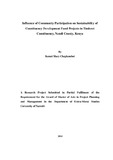| dc.description.abstract | Community participation is a concept that is frequently mentioned in community development. Practitioners in development believe that in order for projects to succeed, communities need to actively take part in designing, implementing and shaping the projects that affect them. The aim of this study was to evaluate community participation by measuring quantitative and qualitative indicators of participation. It is important to note that there are no universal indicators of participation. The objectives of the study, was to determine the extent to which community members participate in project identification and its impact on sustainability of CDF projects in Tinderet Constituency, to investigate the influence of community participation in design and planning on sustainability of CDF projects in Tinderet Constituency, to establish the extent to which communities participate in project implementation on sustainability of CDF projects in Tinderet constituency and to assess the degree to which community members participate in monitoring and evaluation and its impact on sustainability of CDF projects in Tinderet constituency. The study was conducted in Tinderet Constituency, Kenya. The study utilised a descriptive research design technique. The target population for the study involved 11 CDFC members, 39,109 Tinderet constituents and 20 PMC members. The final sample size involved 11 CDFC members, 20 PMCs and 351 community members. The community members‟ were selected through cluster random sampling while the PMCs and CDFC officials were selected through census method. The data was collected through questionnaires and interview schedules. The research instruments were tested for validity and reliability before being taken to the field. Data collected was analysed using descriptive statistics for quantitative data and using themes for qualitative data. Data analysed has been presented using frequencies distribution tables, histograms and column graphs. The study found out that only 43.5% of community members participated in CDF projects identification, 12.5% participated in project design and planning, 47.7% were involved in CDF project implementation, while only 6.5% were involved in monitoring and evaluation processes. The study also showed that there existed a significant difference (p<0.05) between community participation in sustainability of CDF projects although correlation results revealed that the relationship was weak. Some projects were found to have stalled while others were found to be incomplete and this could be due to non-involvement of communities in all the phases of the project cycle. The study recommends that the level of participation in projects should be increased; and the communities should continue with their methods of organization with more emphasis on regular awareness forums to encourage citizens to participate in development projects so as to ensure that projects funded by CDF become sustainable. | en_US |



